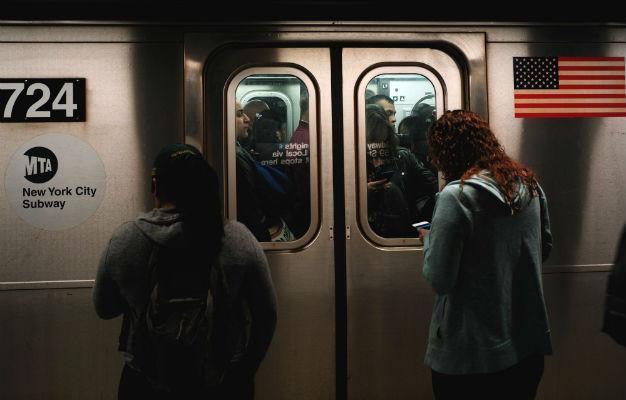New York subway on the brink
NEW YORK - Agence France-Presse

AFP photo
The New York subway is the seventh busiest in the world and has its highest ridership in 70 years, increasing delays and forcing management to formulate a plan of salvation.
The morning commuter crush in Brooklyn, the city's most populated borough, can be overwhelming. Tempers can fray. Sometimes commuters have to wait for at least one, if not two trains to go by before they can board.
"I saw two women pulling each other's hair because they had bumped into each other," said commuter Ana Fernandez, although such behavior is rare.
Kevin Ortiz, spokesman for the Metropolitan Transportation Authority (MTA) that operates the subway, said: "We are a victim of our own success."
In 2015, New Yorkers clocked up 1.76 billion journeys on the subway, the highest number since 1948 and an increase of 61 percent in 20 years.
The city's population has grown by nearly a million since 1994 and crime in the subway, at an all-time high in the early 1990s, has drastically fallen.
Since 1981, $115 billion has been invested in what is one of the oldest subway networks in the world, which Ortiz described as having been in a "state of decay and disrepair" in the early 1980s.
Today, it is considered the quickest and cheapest mode of transport around the city and operates 24 hours a day, seven days a week.
David King, assistant professor of urban planning at Columbia University, said the transit system is largely in good repair.
"Crowding issues are likely a larger source of troubles," he said. "The trains are safe and clean, and breakdowns are rare."
A looming closure of the tunnel that connects the ultra-hip Brooklyn neighborhood of Williamsburg to Manhattan, for possibly 18 months of repair work, is likely to make overcrowding even worse.
The 4, 5 and 6 lines that ply much of the same route from Brooklyn, up the eastern side of Manhattan to the Bronx have more passengers than the entire subway systems in Boston, Chicago and Washington put together.
"I go early, before the rush," said Fernandez, who commutes on the 6 line.
A recent report from the New York state comptroller has highlighted an increase in delays, which the MTA attributes largely to the need to do maintenance work while ensuring that the subway operates 24 hours a day.
"It is certainly a challenge to meet that increased demand," said Ortiz, who outlined various steps that the MTA is taking in the short and the long-term.
All trains are currently being used but the plan is to upgrade existing equipment. The MTA has ordered a new type of train that has no separation between carriages and would increase capacity.
MTA is also rolling out advanced signaling, the Communications-Based Train Control, which pinpoints the precise location of each train, allowing operators to run trains closer together to provide more service.
In the longer term, New York plans to extend the Q line to help relieve pressure on the 4, 5 and 6 lines, billed as the first major expansion of the subway system in more than 50 years.
Beyond the scope of the MTA, some blame exponential growth of parts of Brooklyn, where high-rise towers are being built in the place of older, smaller buildings.
"They're overdeveloping when it comes to real estate with absolutely no plans for infrastructure -- transportation, schools, everything," said David Dobosz, a retired teacher from Brooklyn.
"There needs to be a thorough and robust conversation with the city as they move forward with development plans," recognized Ortiz. "There needs to be more of a robust collaboration between us and the city."
But the situation is not unique to New York. Chicago, San Francisco and Washington have also all launched large-scale projects to upgrade their subways.
